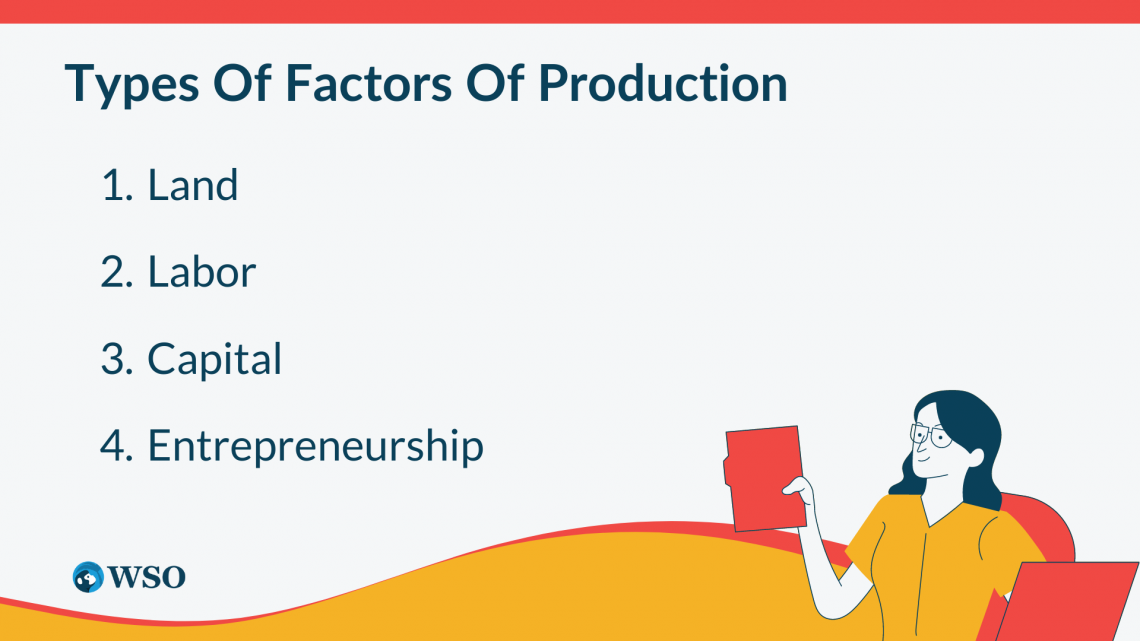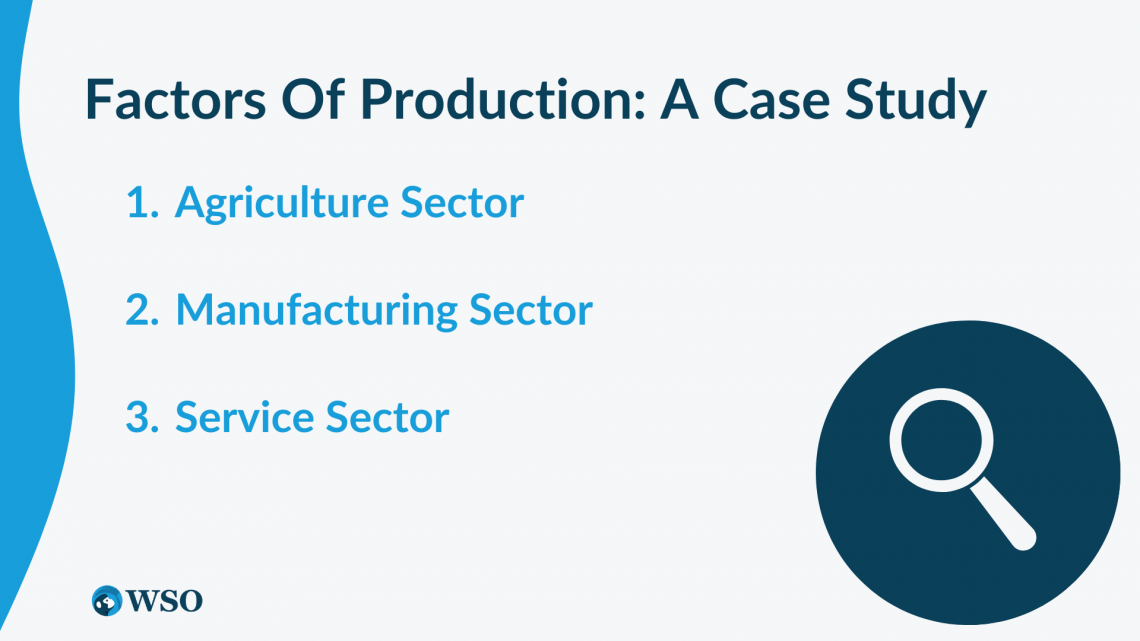Factors of Production
Inputs required to manufacture goods and services
Factors of production refer to the assets and inputs required to manufacture goods and services in an economy. These factors are crucial in transforming raw materials into finished products.

The traditional factors of production include:
- Land
- Labor
- Capital
- Entrepreneurship
In a capitalist system, private ownership of the factors of production is prevalent. Individuals or private entities own and control land, labor, capital, and entrepreneurship.
Capitalism emphasizes free markets and competition, allowing individuals to invest capital, employ labor, and own and manage businesses for profit.
In a socialist system, the state or the public commonly holds ownership of factors of production. The state takes control of industries and resources, and production decisions are often made centrally.

The aim is to promote equality and distribute resources more equitably among the population, minimizing wealth disparities. In a mixed economy, private and public ownership of factors of production coexist. Most modern economies fall under this category.
Private individuals or companies own and operate a significant portion of the factors of production, while the government intervenes to regulate and provide public goods and services.
Key Takeaways
- The factors of production include land, labor, capital, and entrepreneurship, which are essential resources and inputs for producing goods and services.
- The factors of production are interdependent and interconnected, working together to ensure efficient utilization and coordination.
- The efficient combination and utilization of the factors of production lead to increased productivity, economic growth, and improved living standards.
- The ownership and control of the factors of production can vary across different economic systems, such as capitalism, socialism, and mixed economies.
- Understanding the factors of production and their interrelationships is crucial for optimizing resource allocation, fostering economic growth, and promoting overall economic prosperity.
What Are the Factors of Production?
There are four types of factors of production, and each type plays a unique role in the production process and contributes to economic growth and development.

Let's explore each type in detail with examples:
1. Land
The land encompasses all natural resources used in the production process. It includes agricultural land, forests, minerals, water bodies, and other physical resources. The land is important for various kinds of economic interests, along with farming, mining, and construction.
EXAMPLE
A farmer uses the land to grow vegetation, a mining operation mines the earth for minerals, and a production business uses the land to build infrastructure.
2. Labor
Labor refers to the human effort involved in the production process. It includes both physical and mental work contributed by individuals. Labor may be classified into skilled and unskilled, depending on the extent of information and knowledge required for a selected task.
NOTE
Skilled labor involves specialized knowledge and abilities like doctors, engineers, or software developers. Unskilled labor refers to tasks that require minimal training, such as agricultural workers or assembly line workers in a factory.
3. Capital
Capital represents man-made resources used in production. Physical capital, such as equipment, tools, and buildings, in addition to monetary capital, cash, and investments, are all included.
Physical capital enhances productivity and efficiency by providing the necessary tools and infrastructure for production. For instance, a factory utilizes machines and equipment to manufacture goods, while a software company relies on computers and software programs.
NOTE
Financial capital offers the resources required to launch or grow a business.
4. Entrepreneurship
The capacity to spot possibilities, coordinate resources, manage risks, and innovate during the production process is called entrepreneurship. By bringing new goods, services, and technologies, entrepreneurs significantly contribute to economic progress.
They bring together the other factors of production and assume the responsibility of managing and coordinating their activities.
EXAMPLE
An experienced businessperson might launch a new tech startup and combine creative ideas, financial resources, and skilled labor to produce a disruptive good or service.
Understanding the different types of factors of production and their roles is essential for optimizing resource allocation, driving economic growth, and fostering innovation in an economy.
Factors Of Production: A Case Study
Factors of production are essential components that contribute to a country's or industry's economic activity. We will examine how factors of production operate in three sectors: agriculture, manufacturing, and service through the below case study.

1. Agriculture Sector
In the agriculture sector, the primary factor of production is land. The land encompasses all natural resources used for cultivation, including arable land, water, and forests. Farmers require fertile soil, adequate water supply, and favorable climate conditions to grow crops effectively.
Labor is another crucial factor in agriculture, involving the physical effort and skills required for farming activities.
Farmers, agricultural workers, and farm managers contribute their labor to cultivate and harvest crops. They perform tasks such as planting, tending to crops, and harvesting agricultural produce.
Capital investment is necessary in the agriculture sector, involving machinery, tools, and infrastructure.
NOTE
Farmers use tractors, irrigation systems, and storage facilities to enhance productivity and efficiency. These capital investments enable effective farming practices.
Entrepreneurship is also essential in agriculture. Farmers make decisions regarding crop selection, land management, and investment in new technologies. They take risks and innovate in farming practices to optimize production and profitability.
2. Manufacturing Sector
In the manufacturing sector, capital and labor are the primary factors of production. Capital includes physical assets like machinery, equipment, factories, and warehouses. These capital investments enable the production of goods on a larger scale and with increased efficiency.
Labor in manufacturing involves the skilled and unskilled workforce that operates the machinery, assembles products, and manages production processes. They contribute their physical and mental effort to ensure smooth manufacturing operations.
Entrepreneurs in this region drive innovation, put money into studies and development, and create new merchandise to meet customer demands.
NOTE
Entrepreneurs play a vital role in bringing new goods to the market and driving industry growth.
Raw materials sourced from the agriculture sector or other industries also form an important input for manufacturing processes. These materials are transformed into finished products through manufacturing operations.
3. Service Sector
The service sector primarily relies on labor as a factor of production. Skilled individuals provide healthcare, education, finance, hospitality, and transportation services.
Labor in the service sector includes a wide range of specialists, including doctors, teachers, bankers, hotel personnel, drivers, and consultants.
NOTE
Labor contributes their skills, knowledge, and customer service abilities to deliver quality services.
While capital investments in the form of infrastructure and equipment may be necessary for certain service industries, they are generally less prominent compared to the manufacturing sector.
Entrepreneurship in the service sector involves identifying gaps in the market, developing innovative service offerings, and managing service-based enterprises.
Connecting The Factors of Production
The factors of production are the resources required to produce goods and services in an economy. These factors include land, labor, capital, and entrepreneurship.

While each thing has its personal unique traits and contributions, they're interdependent and interconnected in the production technique.
The land is the natural source available in an economic system, such as:
- Forests
- Minerals
- Water
- Agricultural land
It provides the raw materials necessary for production. However, land alone cannot generate goods or services without the other factors.
Labor, which refers to the physical and mental effort put forth by individuals, is required to utilize and transform land resources into productive outputs.
NOTE
Workers apply their skills, knowledge, and expertise to extract and process raw materials.
Capital refers to the machinery, equipment, buildings, and infrastructure that might be used in the manufacturing technique. It is created by combining land and labor, as workers use their skills to produce these capital goods.
Capital enhances productiveness, permitting efficient use of resources and manufacturing a greater quantity of goods. However, capital itself requires land and labor for its creation and maintenance.

Entrepreneurship plays a vital role in coordinating the other factors of production. Entrepreneurs identify opportunities, bring together land, labor, and capital, and take risks to start and manage businesses.
They make decisions regarding the following:
- Allocation of resources
- Production methods
- Pricing strategies
NOTE
Without entrepreneurship, the other factors of production would lack direction and coordination, resulting in inefficiencies and suboptimal outcomes.
The interdependence of these factors can be seen through their complementary nature:
- The land is enhanced by labor and capital
- Labor relies on land and capital for employment and productivity
- Capital requires land and labor for creation and utilization
Entrepreneurship integrates and directs the other factors toward productive ends
They work together as a system, with the output of one factor becoming the input of another. For example, consider a manufacturing process. Raw materials (land) are extracted and transformed by workers (labor) using machinery (capital) to create finished products.
Entrepreneurs oversee the entire process, making decisions about sourcing materials, production methods, and marketing strategies. Without these factors, the production process would be incomplete or inefficient.
Conclusion
Production consists of land, labor, capital, and entrepreneurial activity. They collaborate in a coordinated way to produce items and services and are interdependent on one another.

It is essential to comprehend those components' importance to correctly allocate assets, increase productivity, and promote economic development.
Policymakers, companies, and individuals need thorough expertise in those components and their interactions to manage and utilize sources for sustainable financial advancement efficiently.
The ownership of factors of production influences resource allocation, wealth distribution, and the overall functioning of an economy. Different economic systems adopt varying approaches to ownership based on their underlying principles and goals.
NOTE
Land, labor, capital, and entrepreneurship are all interrelated and connected as part of the production process. They rely on each other for their creation, utilization, and coordination.
The efficiency and productivity of the production system depend on the effective integration and collaboration of these factors. Understanding their interdependence is essential for optimizing resource allocation and achieving sustainable economic growth.




or Want to Sign up with your social account?